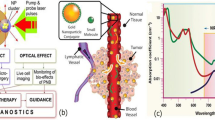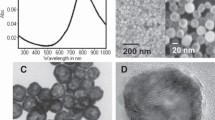Abstract
Palladium-bacteriopheophorbide (WST09), a novel bacteriochlorophyll derivative, is currently being investigated for use as a photodynamic therapy (PDT) drug due to its strong absorption in the near-infrared region and its ability to efficiently generate singlet oxygen when irradiated. In this study, we determined the pharmacokinetics and tissue distribution of WST09 in female EMT6 tumour-bearing Balb/c mice in order to determine if selective accumulation of this drug occurs in tumour tissue. A total of 41 mice were administered WST09 by bolus injection into the tail vein at a dose level of 5.0 ± 0.8 mg kg−1. Three to six mice were sacrificed at each of 0.08, 0.25, 0.5, 1.0, 3.0, 6.0, 9.0, 12, 24, 48, 72, and 96 h post injection, and an additional three control mice were sacrificed without having been administered WST09. Terminal blood samples as well as liver, skin, muscle, kidney and tumour samples were obtained from each mouse and analyzed for palladium content (from WST09) using graphite furnace atomic absorption spectroscopy (GFAAS). The representative concentration of WST09 in the plasma and tissues was then calculated. Biphasic kinetics were observed in the plasma, kidney, and liver with clearance from each of these tissues being relatively rapid. Skin, muscle and tumour did not show any significant accumulation at all time points investigated. No selective drug accumulation was seen in the tumour and normal tissues, relative to plasma. Thus the results of this study indicate that vascular targeting resulting from WST09 in the circulation, as opposed to selective WST09 accumulation in tumour tissues, may be responsible for PDT effects in tumours that have been observed in other WST09 studies.
Similar content being viewed by others
Abbreviations
- GFAAS:
-
graphite furnace atomic absorption spectroscopy
- WSTO9/TOOKAD:
-
palladium-bacteriopheophorbide
- PDT:
-
photodynamic therapy
- AUC0−tlast:
-
area under the drug concentration vs. time plot from 0 h to the last quantifiable value
- AUC0−∞:
-
area under the drug concentration vs. time plot from 0 h to infinity
- Cl:
-
rate of total clearance of the drug
- Cmax:
-
highest drug concentrationmeasured following administration
- kα:
-
drug distribution rate constant
- kβ:
-
drug elimination rate constant
- t1/2α:
-
drug distribution half-life
- t1/2β:
-
drug elimination half-life
- tmax:
-
time at which the highest drug concentration is measured following administration
- Vd:
-
apparent volume of initial drug distribution
- IR:
-
infrared
- UV-Vis:
-
ultraviolet-visible
- HPLC:
-
high pressure liquid chromatography
- rpm:
-
revolutions per minute
- HDL:
-
high density lipoproteins
References
V. Rosenbach-Belkin, L. Chen, L. Fiedor, I. Tregub, F. Pavlotsky, V. Brumfeld, Y. Salomon and A. Scherz, Serine conjugates of chlorophyll and bacteriochlorophyll: Phototoxicity in vitro and tissue distribution in mice bearing melanoma tumors Photochem. Photobiol. 1996 64 174–181.
R. K. Pandey, D. A. Bellnier, K. M. Smith and T. J. Dougherty, Chlorin and porphyrin derivatives as potential photosensitizers in photodynamic therapy Photochem. Photobiol. 1991 53 65–72.
B. W. Henderson, A. B. Sumlin, B. L. Owczarczak and T. J. Dougherty, Bacteriochlorophyll-a as a photosensitizer for photodynamic treatment of transplantable murine tumors J. Photochem. Photobiol. B: Biol. 1991 10 303–131.
Q. Chen, Z. Huang, D. Luck, J. Beckers, P. H. Brun, B.C. Wilson, A. Scherz, Y. Salomon and F. Hetzel, Preclinical studies in normal canine prostate of a novel palladium-bacteriopheophorbide (WST09) photosensitizer for photodynamic therapy of prostate cancer Photochem. Photobiol. 2002 76 438–445.
A. Tremblay, S. Leroy, L. Freitag, M. C. Copin, P. H. Brun and C. H. Marquette, Endobronchial photoxicity of WST09 (Tookad®), a new fast-acting photosensitizer for photodynamic therapy: Preclinical study in the pig Photochem. Photobiol. 2003 78 124–130.
B. W. Hendersen and T. J. Dougherty, How does photodynamic therapy work? Photochem. Photobiol. 1999 55 145–147.
D. A. Bellnier, W. R. Potter, L. A. Vaughan, T. M. Sitnik, J. C. Parsons, W. R. Greco, J. Whitaker, P. Johnson and B. W. Henderson, The validation of a new vascular damage assay for photodynamic therapy agents Photochem. Photobiol. 1995 62 896–905.
N. L. Oleinick and H. H. Evans, The photobiology of photodynamic therapy: Cellular targets and mechanism Radiat. Res. 1998 150–156.
N. V. Koudinova, J. H. Pinthus, A. Brandis, O. Brenner, P. Benedel, J. Ramon, Z. Eshhar, A. Scherz and Y. Salomon, Photodynamic therapy with Pd-bacteriopheophorbide (TOOKAD): successful in vivo treatment of human prostatic small cell carcinoma xenografts Int. J. Cancer. 2003 104 782–789.
F. Borle, A. Radu, C. Fontolliet, H. Van den Bergh, P. Monnier and G. Wagnières, Selectivity of the photosensitizer Tookad® for photodynamic therapy evaluated in the Syrian golden hamster cheek pouch model tumor model Br. J. Cancer 2003 89 2320–2326.
F. Borle, A. Radu, P. Monnier, H. Van den Bergh and G. Wagnières, Evaluation of the photosensitizer Tookad for photodynamic therapy on the Syrian golden hamster cheek pouch model: Light dose, drug dose and drug-light interval effects Photochem. Photobiol. 2003 78 377–392.
S. Schreiber, S. Gross, A. Brandis, A. Hermelin, V. Rosenbach-Belkin, A. Scherz and Y. Salomon, Local photodynamic therapy (PDT) of rat glioma xenografts with Pd-bacteriopheophorbide leads to decreased metastatases and increase of animal cure compared with surgery Int. J. Cancer 2002 99 279–285.
B. W. Henderson and S. O. Gollnick, Mechanistic Principles of Photodynamic Therapy, in Biomedical Photonics Handbook, ed. T. Vo-Dinh, CRC Press, Boca Raton, FL, 2003, ch. 36.
M. Bucking, E. F. Gudgin Dickson, M. Farahani, F. Fischer, D. Holmes, G. Jori, J. C. Kennedy, M. E. Kenny, X. Peng, R. H. Pottier and G. Weagle, Quantification of the selective retention of palladium octabutoxynaththalocyanine, a potential photothermal drug, in mouse tissues J. Photochem. Photobiol. B: Biol. 2000 58 87–93.
J. L. DeGroot, Investigations of palladium-bacteriopheophorbide and palladium(ii) octabutoxynaphthalocyanine in an AMT6 tumour-bearing Balb/c mouse model, MSc Thesis, Department of Chemistry and Chemical Engineering, The Royal Military College of Canada, Kingston, 2002.
P. H. Brun, M. Bucking, J. L. DeGroot, E. F. Dickson, M. Farahani and R. H. Pottier, Neutron activation and liquid scintillation analysis of tissue samples containing palladium bacteriochlorophyll derivative, a potential photochemotherapeutic agent Can. J. Appl. Sci. Spectrosc. 2004 49 55–63.
L. Shargel, and A. Yu, Applied Biopharmaceutics & Pharmacokinetics, Appelton & Lange, Stamford, CT, 1999.
A. Scherz, S. Katz, Y. Vakrat, V. Brumfeld, E. Gabelmann, J. Zilberstein, D. Leopold, J. R. Norris, H. Scheer and Y. Salomon, Bacteriochlorophyll-serine based photochemotherapy; Type III? in Photosynthesis: Mechanisms and Effects, ed. G. Garab, Kluwer Academic Publishers, Dordrecht, Netherlands, 1998, pp. 4207–4212.
J. Zilberstein, S. Schrieber, M. C. W. M. Bloemers, P. Bendel, M. Neeman, E. Schechtman, F. Kohen, A. Scherz and Y. Salomon, Antivascular treatment of solid melanoma tumors with bacteriochlorophyll-serine-based photodynamic therapy Photochem. Photobiol. 2001 73 257–266.
M. Aprahamian, S. Evrard, P. Keller, M. Tsuji, G. Balboni, C. Damge and J. Marescaux, Distribution of pheophorbide a in normal tissues and in an experimental pancreatic cancer in rats Anti-Cancer Drug Des. 1993 8 101–114.
V. Cuomo, G. Jori, M. E. Kenney and M. A. J. Rodgers, Liposome-delivered Si(ii)-naphthalocyanine as a photodynamic sensitiser for experimental tumours: pharmacokinetic and phototherapeutic studies Br. J. Cancer 1990 62 966–970.
E. Reddi, C. Zhou, R. Biolo, E. Menegaldo and G. Jori, Liposome- or LDL-administered Zn(ii)-phthalocyanine as a photodynamic agent for tumours. I. Pharmacokinetic properties and phototherapeutic efficiency Br. J. Cancer 1990 61 407–411.
R. Biolo, G. Jori, J. C. Kennedy, P. Nadeau, R. Pottier, E. Reddi and G. Weagle, A comparison of fluorescence methods used in the pharmacokinetic studies of Zn(ii)phthalocyanine in mice Photochem. Photobiol. 1991 53 113–118.
C. Ometto, C. Fabris, C. Milanesi, G. Jori and D. A. Russell, Tumour-localising and -photosensitising properties of a novel zinc(ii) octadecylphthalocyanine Br. J. Cancer 1996 74 1891–1899.
Author information
Authors and Affiliations
Corresponding author
Rights and permissions
About this article
Cite this article
Brun, P.H., De Groot, J.L., Gudgin Dickson, E.F. et al. Determination of the in vivo pharmacokinetics of palladium-bacteriopheophorbide (WST09) in EMT6 tumour-bearing Balb/c mice using graphite furnace atomic absorption spectroscopy. Photochem Photobiol Sci 3, 1006–1010 (2004). https://doi.org/10.1039/b403534h
Received:
Accepted:
Published:
Issue Date:
DOI: https://doi.org/10.1039/b403534h




